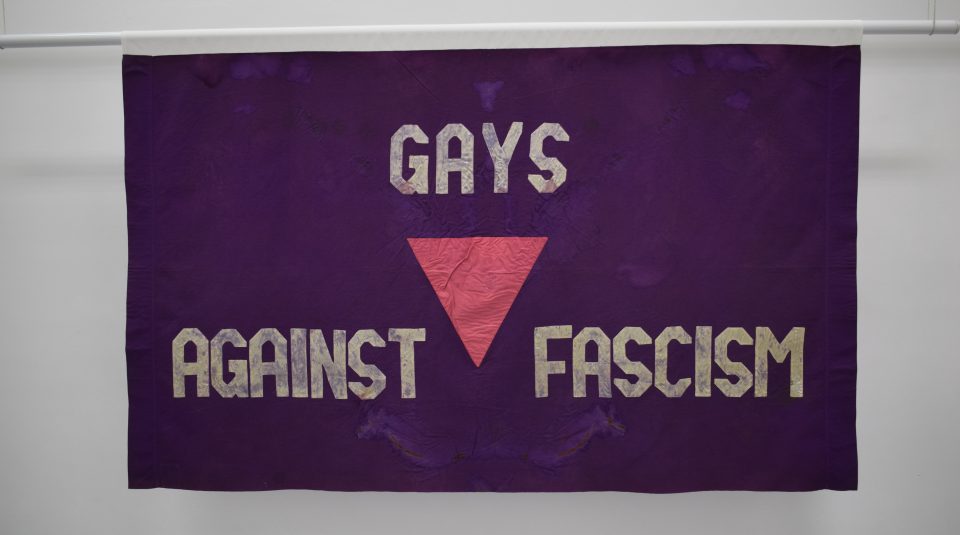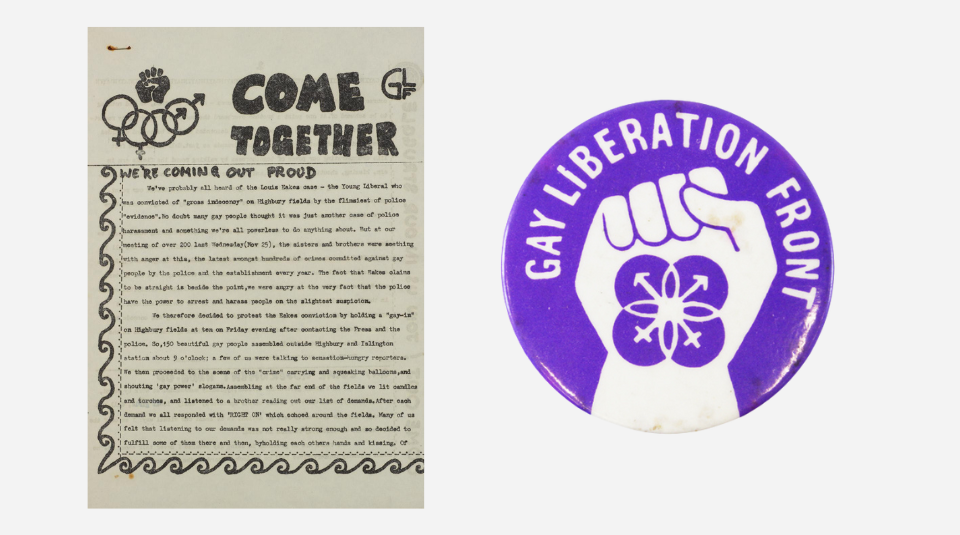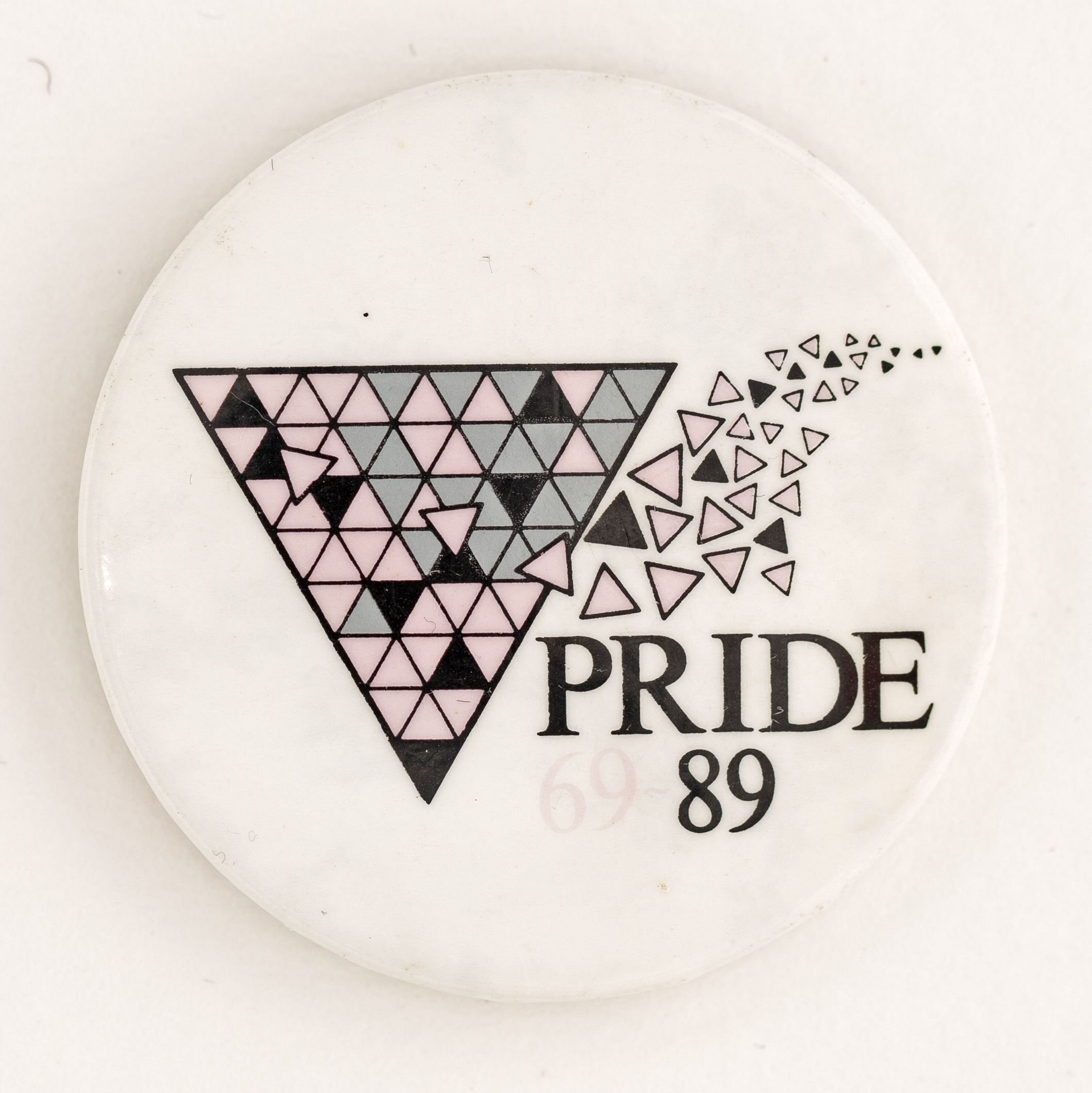


The LGBTQI+ community has created their own language of colours and symbols. In this guest blog Gillian Murphy, Curator for Equality, Rights and Citizenship at LSE Library, explores the symbols created through activism, logo competitions, resistance, and community. LGBT+ History Month is celebrated each February in the UK.
“Well, of course, a symbol can mean anything you want it to mean.” Come Together, Issue 12, 1971.
The use of symbols and colours is an important way for groups to convey messages, communicate with others, and to build a visual identity. During the 1970s, LGBTQI+ people were encouraged to come out and, in doing this, they often wore badges with distinctive symbols, reinforcing the belief that no longer would they be invisible. This blog looks at some of the symbols that can be found in LGBTQI+ collections.
The gender symbols for male and female are traditionally derived from astrological signs and mythological meanings representing Mars (god of war with shield and spear) and Venus (mirror of Venus, goddess of love and beauty) respectively.
From the first issues of Come Together, the short-lived newspaper produced by the Gay Liberation Front (GLF) from late 1970, double male and double female gender symbols were used on the front covers to represent gay men and lesbians.

By Issue 8 of Come Together for August 1971, the more recognisable symbol of GLF was used and early photographs of GLF members show them wearing badges with this design. The badge is purple with a white clenched fist (a widely recognised symbol of resistance) with a purple flower and white male / female symbols in its palm. ‘GAY LIBERATION FRONT’ in white capitals is printed around the top edge.

Towards the end of 1971, a new GLF badge was advertised in Come Together (Issue 11), available for the price of 5p. This badge showed the symbol of the planet Jupiter (or Jove). It was an alternative to the symbol of Mars and Venus and the gender binary as it represented the qualities of good nature and joviality. The fist was added later. A short article in Issue 12 of Come Together provided more information about the choice of the symbol for Jupiter explaining that it was one of the more mysterious and powerful planets concerned with a higher life, in the same way that GLF was. The new design can be seen in a number of ephemeral pieces in the LSE Library archive.

The downward pointing pink triangle, the symbol used to identify LGBT+ people in Nazi concentration camps during World War II, was reclaimed in the 1970s by different LGBT+ groups and campaigns. You can see the pink triangle in the badge of the London Gay Teenage Group and Gays Against Fascism banner, pictured above.

The pink triangle was also used by the radical, non-violent, direct action group OutRage! The wooden cross pictured above has a pink triangle with the words ‘Stop Crucifying Queers’ written on it as part of their campaign to highlight the Vatican’s condemnation of homosexuality in the 1990s.
The pink triangle is seen above on the homemade badge for the campaign to repeal Section 28 of the Local Government Act 1988, and as the logo for the Hall-Carpenter Archives, set up in the 1980s…

…and used on badges for gay pride in the 1970s and 1980s. The logo on the badge above for pride 1989 was designed by the See Red Women’s Workshop collective to mark 20 years since the Stonewall riots in New York.

The direct action group ACT-UP (AIDS Coalition to Unleash Power), set up in March 1988 in New York, adopted the triangle pointing upwards as its logo. Act-Up London produced its first newsletter Action News in May 1989 and you can see the logo on these items, pictured above.

The lower case lambda, the eleventh letter of the Greek alphabet, was chosen by the American gay activist, Tom Doer, to be the logo for the Gay Activists Alliance in New York in 1970. The lambda symbol has different meanings. In chemistry, it denotes a catalyst or change, and it is probably in this sense that it was picked by Doer.
The International Gay Rights Congress was held in Edinburgh in December 1974 and formally recognised the lambda as the symbol for lesbian and gay activism. The lambda features on badges, banners, and newsletters such as Pa’fuera! (Out!), pictured above, the newsletter of the Communidad de Orgullo Gay (Gay Pride Community) of San Juan in Puerto Rico.
On the badge above for the Campaign for Homosexual Equality, the lambda can be seen inside the pink triangle.

The double-headed axe or labrys pictured above was an important symbol of the Minoan religion in ancient Crete and associated with goddesses. In the 1970s, the labrys became a symbol of women’s empowerment, particularly for lesbians.

During the mid 1980s, the London Bisexual Group ran a logo competition asking members to submit their ideas for a ‘Bisexuality Pride’ symbol. Above is a page from their newsletter Bi-Monthly with some of the entries.
The winning logo was designed by John Barker from Yorkshire and featured on following issues of Bi-Monthly.

In 1985, the Black Lesbian and Gay Centre Project was set up to explore the possibility of securing a permanent centre in London, which became a reality in 1992. The See Red Women’s Workshop designed a very distinctive logo for the group as seen on the flyer above.
Gillian Murphy is the Curator for Equality, Rights and Citizenship at LSE Library. She promotes collections that relate to rights and equalities which mainly involves working with The Women’s Library and the Hall-Carpenter Archives. She organises various engagement activities which draw on the collections. These range from curating public exhibitions, planning events and talks, to holding workshops for people to experience the material LSE Library holds.
Guest blogs are not curated by PHM but feature voices on topics relevant to the museum’s collection. Guest blogs do not necessarily reflect the views of PHM. Images supplied by contributor.
The British Library of Political and Economic Science (@LSELibrary) was founded in 1896, a year after the London School of Economics and Political Science. It has been based in the Lionel Robbins Building since 1978 and houses many world class collections, including the Women’s Library and Hall-Carpenter Archives.
Find out more about LGBT+ collections at LSE Library and about the history of the Hall-Carpenter Archives.
Read about the history of the symbol of the raised fist.
Read about HIV/AIDS activism in a blog about the Mark Ashton Trust.
Subscribe to PHM’s e-newsletter to keep up to date with our latest blogs and upcoming events.
An earlier version of this blog was first published in February 2024.